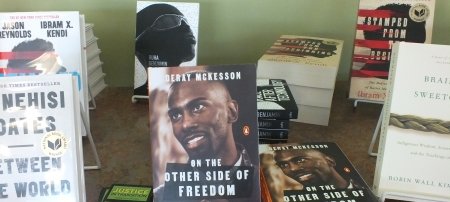Researcher Studies Hockey and Football Concussions: Is it Time for Major Changes?
Imagine ice hockey without body checking and football with less hitting. What might sound blasphemous to hockey and football fans and players has more support than you may imagine. And a Michigan Tech researcher is a large part of that conversation.
Syd Johnson, assistant professor of philosophy and adjunct professor of kinesiology and integrative physiology, has studied the impact of concussions and is joining those who urge revolutionary changes in hockey and football. Her timing is right.
“When Sidney Crosby [of the Pittsburgh Penguins] got his concussion and was lost for the season, it attracted a lot of attention,” she says.
Arguably the world’s greatest hockey player, Crosby sat out most of the 2010–11 National Hockey League season, returned this year, and is out again with a concussion-related ailment.
Johnson used Crosby’s injury as an example in a 2011 article published in the Canadian Medical Association Journal, where she promotes no body checking until elite level programs (ages 16 to 17).
The response to her recommendation was “tremendous” in Canada, she said, resulting in numerous radio and TV interviews across the country, and a few in the lower 48, including on CNN and in Pittsburgh, home to the concussion heard ‘round the world.
Johnson’s work with concussions has an important focus.
“I’m most interested in changes in the way hockey and football are played for the recreational and junior players who won’t make professional leagues,” Johnson says. “Youth are a neglected population of players when it comes to studying the effects of concussions. Nobody really knows the long-term consequences, nobody has studied them.”
Johnson’s research also taps into the culture of sports, she says.
“As adults, we need to protect kids from injury,” she says. “Sports are valuable. They help fight obesity, for example. But there are ethical implications. What’s important in sports? What are we teaching kids?"
Johnson says that players in sports need to be respected as humans, not merely replaceable beings for our entertainment. Many examples of athletes’ lives forever changed are becoming more prominent.
Chris Henry, former wide receiver for the NFL’s Cincinnati Bengals, died of injuries in a car accident, after years of dangerous and illegal behavior. An autopsy revealed that Henry had developed chronic traumatic encephalopathy. Another victim of CTE was football player Dave Duerson, who committed suicide. He left is brain for research after his death.
“It is believed that one of the causes of CTE is sub-concussive impacts, the kind of ordinary hits that athletes routinely take in the course of play,” Johnson says. “ Solving the CTE problem will require radical changes to football and hockey. It’s a condition that can’t be diagnosed, doesn’t have clear symptoms, and can’t be treated.”
So, post-concussion guidelines don’t do anything about CTE, she adds. How many more players are similarly affected is unknown.
Michigan Tech’s head football coach Tom Kearly said they are extra careful about their athletes. “We’ve always been careful, and we have clear protocol to follow before allowing players to return to competition, working with our trainers and doctors.”
Brian Brewster, athletic trainer at Tech, says that protocol includes the same tests used by the NFL and NHL, as well as other major sports.
“We do a neurocognitive assessment using computer software," he says. “Student athletes in contact sports take a baseline test before they are allowed to participate. The test has many different assessment tools: in one, words or designs are flashed on the screen and the student-athletes are asked later if this was a word or design that was flashed.”
"Once an athlete shows any signs of a concussion, he or she is pulled from all activity for that day,” he adds. “If we have any thoughts that a student may have a concussion, he or she will retake the test and the scores will be compared to a baseline test. We work with Dr. Bruce Trusock [team physician], who interprets the test," he says. "We also look at the individual’s symptoms score [headaches, blurred vision, ringing in ears, etc.] and other clinical signs like balance testing before they are cleared to gradually return to activity.”
Brewster says that once they are cleared for activity, they ride a bike, then on the next day ride a bike and lift. Next they can do a day of practice with no contact; then they are cleared for full participation as long as no signs or symptoms of a concussion come back.
Hockey Tragedies
For hockey, Crosby’s injuries raised flags about concussions, but worse events have
resulted in increasing scrutiny.
The 2011 overdose death of “enforcer” Derek Boogaard and suicides of tough guys Rick Rypien,and Wade Belak have players, fans, and officials questioning the effects of head injuries more than ever.
Anti-checking rules could be driven from the bottom up—youth/junior leagues to the pros—in opposition to the normal way rules change, Johnson says.
She cites women’s hockey, with no body checking, as a positive example. “It’s still hockey,” she says. “And others have agreed that, by introducing checking much later, you can continue to develop important skills in hockey, such as stickhandling and skating.”
As body checking is introduced in older levels (ages 13-14 in the US), players’ concern about hitting and getting hit takes their attention away from those other skills, according to Johnson and others involved in the sport.
Other changes can help protect hockey players, too, she says.
“Teach them to not use their heads as battering rams,” Johnson says. “Teams could make the ice surface bigger. You have bigger players now than years ago, and they are playing in a condensed area. Also, limit the sizes of the equipment, so players don’t think they are invincible in their armor.”
Even legendary hockey personality Don Cherry has acknowledged that oversized shoulder pads, for example, can make players fearless. (Cherry is famous for supporting fighting in hockey, another area that Johnson contends must change.)
“Helmets don’t really help,” Johnson says. “A concussion occurs when your skull goes one way and your brain the other. Helmets help with skull fractures, but they don’t help for concussions, though players still think they do.”
The Canadian Academy of Sports and Exercise has called for a ban on body checking in all levels of minor hockey “which are not designed as training for professional and international ranks.” Body checking would begin in the elite division.
Johnson also acknowledges that 100 percent of hits can never be taken out of football, but they can be can be lessened. And in her latest research, she claims new “return-to-play” guidelines don’t solve the concussion problem.
In another radical change she perceives as necessary, Johnson favors the banning of fighting in hockey, which is accepted in the NHL and North American junior leagues but illegal in European and Olympic hockey.
She says hockey risks becoming marginalized like boxing did after the effects of punching became obvious in Muhammad Ali and Sugar Ray Leonard, among others.
A deeply seated tradition, fighting could be hard to eliminate. It is even celebrated in venues like Don Cherry’s twenty-volume video series “Rock ‘Em, Sock ‘Em Hockey” that focuses on fisticuffs (and body checking).
Johnson argues that the time has come for major changes in two major sports (and elsewhere).
Michigan Technological University is an R1 public research university founded in 1885 in Houghton, and is home to nearly 7,500 students from more than 60 countries around the world. Consistently ranked among the best universities in the country for return on investment, Michigan's flagship technological university offers more than 185 undergraduate and graduate degree programs in science and technology, engineering, computing, forestry, business, health professions, humanities, mathematics, social sciences, and the arts. The rural campus is situated just miles from Lake Superior in Michigan's Upper Peninsula, offering year-round opportunities for outdoor adventure.




Comments